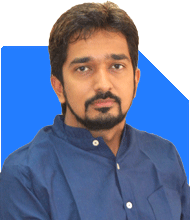Dev Ashish | Answer |Ask -Follow
MF Expert, Financial Planner - Answered on Jun 25, 2024
He provides professional fee-only investment advisory services to small and high networth individuals in order to help them achieve their financial goals.
Ashish's views are regularly published in national business publications. He has an MBA degree from NMIMS, Mumbai and also holds an engineering degree.... more

Hi, I am a 24 year old who has just entered to work. It has been 10 months. I earn approx 42,500 p.m. Out of that, 17,000 goes into a policy. My goal is to have an 18 lakh corpus within 3 years so that I can pay off my education. I have no expenses currently as I stay with my parents. Request you to guide me accordingly
The issue is that out of your Rs 42,500 monthly earnings, an amount of Rs 17,000 is already going towards some policy (details of which are not known). So what is left is about Rs 25,500. So assuming you can save the entire Rs 25,000 towards the goal as suggested above, you can put Rs 7500 in the Aggressive Hybrid Fund and the remaining Rs 17,500 in the Low/Short/Conservative Hybrid Fund.
Since you will be investing less than what is mathematically required, you will not be fully reaching your goal of Rs 18 lakh in 3 years. For that, you need to increase your monthly surplus. Also, do check what your Rs 17,000 monthly policy is exactly about. If it's life insurance (that too LIC traditional plans), then you are better off taking a plain term plan and surrendering that one.
Thanks
Dev Ashish,
SEBI Registered Investment Advisor (Fee-Only RIA)
Founder, StableInvestor.com
Twitter (@Stableinvestor)
Note (Disclaimer) - As a SEBI RIA, I cannot comment on specific schemes/funds that are provided or asked for in the questions in the platform. And the views expressed above should not be considered professional investment advice or advertisement or otherwise. No specific product/service recommendations have been made and the answers here are for general educational purposes only. The readers are requested to take into consideration all the risk factors including their financial condition, suitability to risk-return profile and the like and take professional investment advice before investing.
You may like to see similar questions and answers below
Ramalingam Kalirajan |10902 Answers |Ask -Follow
Mutual Funds, Financial Planning Expert - Answered on Jul 01, 2024
Ramalingam Kalirajan |10902 Answers |Ask -Follow
Mutual Funds, Financial Planning Expert - Answered on Jul 25, 2024
Ramalingam Kalirajan |10902 Answers |Ask -Follow
Mutual Funds, Financial Planning Expert - Answered on Feb 27, 2025
Ramalingam Kalirajan |10902 Answers |Ask -Follow
Mutual Funds, Financial Planning Expert - Answered on Jun 21, 2025
Samraat Jadhav |2514 Answers |Ask -Follow
Stock Market Expert - Answered on Dec 18, 2025
Reetika Sharma |432 Answers |Ask -Follow
Financial Planner, MF and Insurance Expert - Answered on Dec 18, 2025
Reetika Sharma |432 Answers |Ask -Follow
Financial Planner, MF and Insurance Expert - Answered on Dec 18, 2025
Reetika Sharma |432 Answers |Ask -Follow
Financial Planner, MF and Insurance Expert - Answered on Dec 18, 2025
Samraat Jadhav |2514 Answers |Ask -Follow
Stock Market Expert - Answered on Dec 18, 2025

Kanchan Rai |648 Answers |Ask -Follow
Relationships Expert, Mind Coach - Answered on Dec 18, 2025
Kanchan Rai |648 Answers |Ask -Follow
Relationships Expert, Mind Coach - Answered on Dec 18, 2025
Anu Krishna |1754 Answers |Ask -Follow
Relationships Expert, Mind Coach - Answered on Dec 18, 2025
Anu Krishna |1754 Answers |Ask -Follow
Relationships Expert, Mind Coach - Answered on Dec 18, 2025
Anu Krishna |1754 Answers |Ask -Follow
Relationships Expert, Mind Coach - Answered on Dec 18, 2025






















